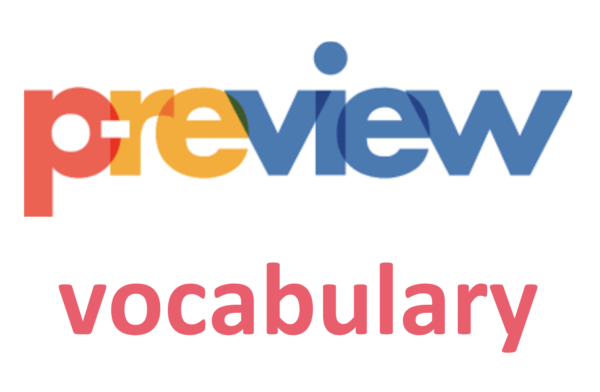Previewing Vocabulary Before Reading

Existing background knowledge is a critical component for comprehension, and word meanings are part of larger knowledge structures about a topic. Knowing the vocabulary words associated with a given topic enables students to connect their background knowledge to what they are reading. What if students aren’t unfamiliar with some of the vocabulary in the text? Many studies have shown that previewing unfamiliar words before students read improves comprehension.
The goals for previewing vocabulary include activating prior knowledge, clearing up student misconceptions about word meaning, and clarifying the meaning of known words in relation to the current context (especially for words with multiple meanings). The most important goal is to provide some familiarity with unknown words so students can make sense of the text when they read.
There may be many words or phrases that are unfamiliar to students, but it is not worth spending time teaching all these words. Previewing is about attaching some meaning to new words rather than deeply learning these words. It is important to provide deep, direct instruction for certain key words, but previewing before reading is not the best time to do this. Previewing should provide students with just enough knowledge about those words that are central to the meaning of what they will read. Graves (2006) says it this way:
“In one case you may just want to introduce the word so the students won’t stumble over it when they see it in an upcoming passage. In another, you will want to give students deep, rich and lasting meaning for a word.”
The point is to not spend a significant amount of time pre-teaching all of the words that may be unfamiliar to students.
What words should be previewed?
Choosing words to preview will depend on the students’ grade levels, vocabulary and background knowledge, and English proficiency. Teachers should use their common sense and knowledge of their students to choose words and not rely on textbooks to identify words for previewing. Here are some suggestions:
- Choose words that are necessary to understand the text.
- Choose words that are essential to understanding the major concepts in the content lesson or unit of study.
- Choose words that are unfamiliar, specialized, academic words (e.g.k metamorphosis, quadrilateral, oligarchy) and non-specialized academic words (e.g., analyze, relationship, synthesize).
- Choose words that are unfamiliar to most of the students.
- Choose words that have unfamiliar multiple meanings and problematic phrases or figures of speech.
Student Rating of Word Knowledge
The growth of word knowledge is slow and incremental, requiring multiple exposures to words. Often students may not know the full meaning of a word or be able to produce a definition, yet they may still have enough familiarity with a word to be able to comprehend while reading.
A word knowledge checklist is a good way to preview words and have students rate their knowledge of words as a preview activity. Wesche and Paribakht (1996) developed The Vocabulary Knowledge Scale that provides five levels of word knowledge:
- I don’t remember having seen this word before.
- I have seen this word before, but I don’t think I know what it means.
- I have seen this word before, and I think it means _____.
- I know this word. It means _____.
- I can use this word in a sentence: __________.
Blachowicz (1986) developed a checklist that provides a choice of three levels of word knowledge, and Beck, McKeown, and Kucan (2002) developed one with four levels. See the examples below.

For more suggestions about previewing vocabulary, see Chapter 3 in our teacher training book The Key Vocabulary Routine.

 Joan Sedita is the founder of Keys to Literacy and author of the Keys to Literacy professional development programs. She is an experienced educator, nationally recognized speaker and teacher trainer. She has worked for over 35 years in the literacy education field and has presented to thousands of teachers and related professionals at schools, colleges, clinics, and professional conferences.
Joan Sedita is the founder of Keys to Literacy and author of the Keys to Literacy professional development programs. She is an experienced educator, nationally recognized speaker and teacher trainer. She has worked for over 35 years in the literacy education field and has presented to thousands of teachers and related professionals at schools, colleges, clinics, and professional conferences.
Very helpful ideas. Thank you!
Thank you for your knowledge. Mine has increased on my background knowledge and the new information to support my understanding of supporting students.
I enjoyed Joan’s videos in the earlier Modules. She has great ideas to help educators help students be better reader and in turn better learners.
excellent
Thank you! This is very helpful.